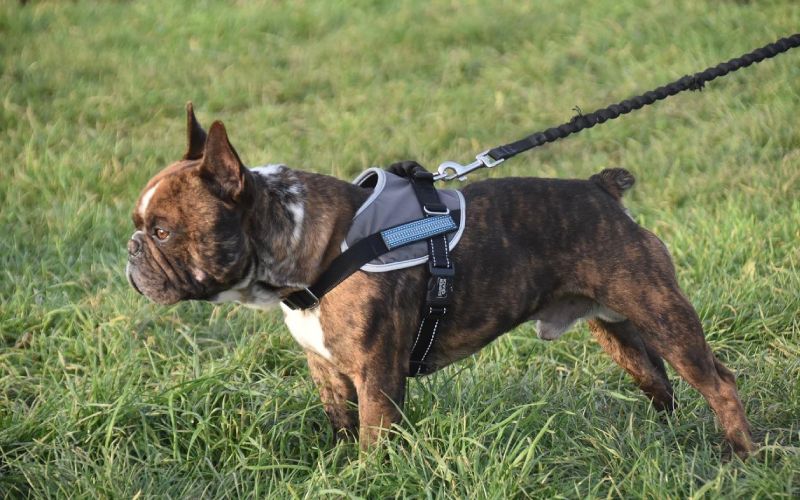At bocadogtrainers.com, Many pet parents ask us whether they should use a harness for their dogs and we always encourage them not to. While harnesses may be suitable and comfortable for some dogs, they are not the best choice for all dogs.
Below are the main reasons why we discourage the use of dog harnesses:
11 Reasons Why We Don’t Like Harnesses
1. A Back-Clip Harness Could Encourage Pulling Behavior
Dog harnesses (especially ones that clip on the back) are not the best choice for dogs that pull or for teaching leash manners to your young dog.
Your dog could easily pull you when it is wearing a back-clip harness and that can become a bad habit. Dogs are curious creatures and they want to sniff everything and greet everyone. With a harness, they can easily pull you on their walks. This habit can become hard to break.
2. Harnesses Could Delay Communication
With a collar, you can simply flick your wrist to communicate with your dog. With a harness, the timing gets delayed because when you flick your wrist, the harness tugs at the dog’s shoulder and not its neck or head.
This results in the delayed timing of telling your dog to do something and indirectly encourages your dog to pull. Your dog simply cannot resist the temptation to pull because the signal comes late from you. With a collar, the signal goes to the dog’s neck right away so your pet knows immediately not to pull.
3. They Could Result In Unclear Communication
Not only does a harness delay communication, but it also confuses your dog. A harness sends the signal to the dog’s shoulders so it gets confused as to what is expected of it. With a collar, the signal goes right away to the neck, enhancing clarity in the dog’s mind of what it is expected to do and not do.
Many commands like Sit, Stay, Heel, Stop, Left, Right, etc. are easier with a voice command followed by a flick of your wrist – provided your dog is wearing a collar. With a harness, this communication gets delayed, resulting in an utter lack of clarity.
4. They May Indirectly Encourage Distractions
Dogs on a harness are not controlled at the head. Since they get controlled only at their shoulder level, they get a lot more free time to move from one distraction to the next. It isn’t the dog’s fault- they have a keen sense of smell and it is only natural for them to want to sniff the next stimulus. A collar makes it a lot easier to control these distractions and teach your dog to walk at a faster pace.
5. They Offer Little Control Over Your Dog
A collar lets you control your dog easily and greatly minimizes dangers like darting into traffic or jumping on other dogs. On the other hand, a harness offers more freedom to your pet while minimizing your control over it.
Moreover, you need to put in a lot more strength to control your dog in a harness than you’d need if it were wearing a collar. This is especially true for large breed dogs or dogs that pull.
6. They May Not Be The Best Choice For Dogs With Health Issues
Harnesses are not the best choice for dogs with certain health issues. Sure, some dogs with tracheal collapse or cervical problems could benefit from harnesses instead of collars. However, for dogs with respiratory problems, a harness could end up exacerbating their wheezing or breathing issues.
7. They Aren’t Suitable For Escape Artists
With a collar, you usually use the two-finger rule to ensure a snug fit. With harnesses, security can be a concern since smart dogs can easily chew through or slip out of them. This can be concerning if you live in an area with traffic.
Collars make it easier to control the head of your dog, making it a lot easier to discourage escape artists.
8. They Could Cause Discomfort to Dogs
Even if a harness fits properly, the straps tend to chafe the dog’s fur. This can result in itchiness, hair loss, and skin issues. Tight harnesses could also injure your dog. We certainly do not recommend harnesses for dogs with thick fur, especially in hot and humid weather.
9. They Do Not Let You Lead Your Dog
With a harness, your dog is more likely to walk ahead of you. As a pack leader and alpha, you must always walk ahead or beside of your dog – never behind. With a dog collar, it is a lot easier to lead your dog or have it heel by your side and walk properly.
10. Some Dogs May Need Training to Get Used to Harnesses
A few dogs need to be trained to get used to wearing a harness. They may feel restricted or even get stressed or anxious. This could also result in behavioral issues.
11. They Are Harder to Put On/Take-Off
There is no doubt that certain harness styles are a lot trickier to put on your dog. It can become a daily struggle to put the harness on your pet before each walk. This can take away all the joy of this activity and could negatively impact the bond between you and your pet.
Give is a call and we can help you walk your dog to make it an enjoyable experience!
561-513-5333
[email protected]
bocadogtrainers.com


